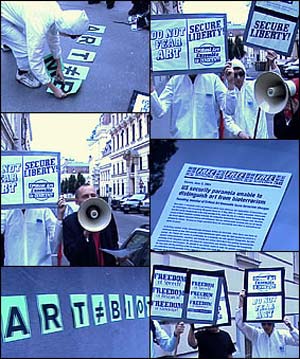Critical Art Ensemble offers readers a book so incendiary that the United States government confiscated the first draft under Section 175 of the US Biological Weapons Anti-Terrorism Act. Here the artist collective keeps in step with its provocative rhetoric and stalwart resistance to state-sanctioned coercion and persistent government manipulation by questioning the biological/germ warfare industry.
While America cranks out billions of tax dollars to fund secret prisons, torture camps and chemical warfare research, the government neglects it own domestic public health crises.
Steve Kurtz, a founding member of Critical Art Ensemble and art professor at the State University of Buffalo, continues to fight a legal battle with the US government, which has charged him with mail fraud. Kurtz caught the paranoid eye of defenders in the War on Terror when his wife died of a heart attack in 2004. Paramedics who had poked around Kurtz's home studio/laboratory after responding to the emergency alerted the FBI and Homeland Security. Vials of benign microscopic samples originally intended for a Critical Art Ensemble installation led to Kurtz's getting dragged into court under a grand jury indictment. The book is a testimony to Critical Art Ensemble's dedication to disseminating subversive information despite governmental interrogation and interference.
Though a substantial amount of the book's research was lost in the raid on Kurtz's home, Marching Plague provides a wealth of information on the ersatz threat of perpetually impending germ warfare and palpable examples of misdirected public funds. The book investigates detailed episodes of military bungling in reenactments and simulations that consistently show germ warfare is messy, inefficient, expensive and sometimes just as deadly for both sides in an altercation. Simply stated, Critical Art Ensemble declares germs to be at "the bottom of the hierarchy of utility." Indeed, germs are expensive to manufacture and hard to control. "Marching Plauge" cites various government attempts to harness a weapon and strategy that can be easily debased by a simple shift in weather patterns.
The authors clearly understand the implications of their assertions, and they're willing to provoke the thought police with their profound and groundbreaking statements. Perhaps the most striking epiphany in this small book comes with absorbing the previously inconceivable notion that "germ warfare is not useful." Critical Art Ensemble breaks apart the war machine's tenuous reasoning for this Brobdingnagian waste of taxpayer money by simply asking, "From a military perspective, when does strategic deterrence with weapons of mass destruction become counterproductive?"
Critical Art Ensemble slogs through the fear and paranoia of a country locked onto the spectacle of a nonexistent biological terrorism threat. In plucking the myths from reality, the collective reveals an industry hell-bent on feeding itself with government money, continuously siphoning from the public coffer instead of solving real public health crises and epidemics. Critical Art Ensemble could easily be one of the most important artist collectives of the 21st century. Their ability to infuse public dialogue with punchy questions and radical ideologies while maintaining the integrity of their art as activism makes this latest effort required reading.
Let's see if they let me take it on the plane to New York City this weekend…
Images courtesy GT editor.
Michelle Gonzalez Valdez is an artist and writer currently living in San Antonio.





